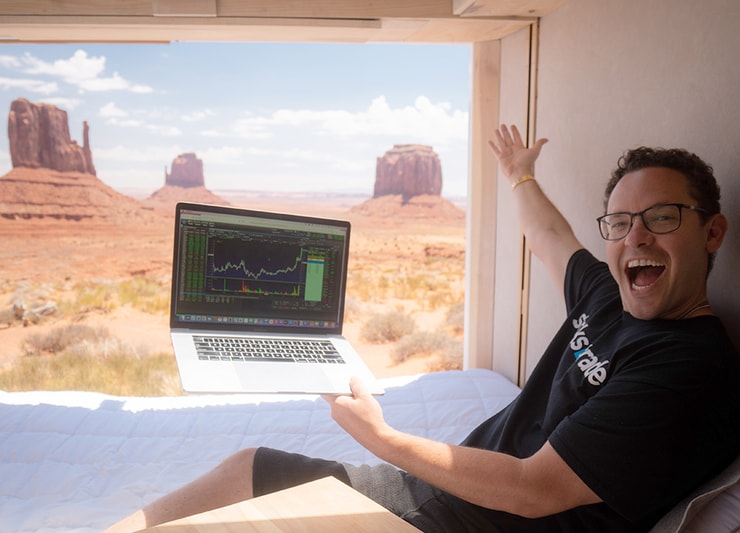There’s a significant shift happening in the market right now and it’s transforming the way you should approach trading.
The eruption of Supernovas isn’t just a hot trend…
It was the cornerstone of how I built my wealth some twenty years ago…and one of the best ways someone with a small account can make giant leaps.
We’ve seen it in stocks like BDRX rising 251% over the weekend…
RDHL spiking by 294% in two days…
MINM exploded by 1201% in one day…
Along with VVOS which had an insane one day move going from $11.93 to $48.79.
Gooooooooooood morning! Nice to wake up to yet another GIANT Supernova like $NEXI after yesterday's awesome play on $MINM which followed $VVOS which followed $RDHL and these Supernovas are ALL this week! See my tweet below as it applies to a T & whiny short sellers can suck it https://t.co/8B8naEaMFb
— Timothy Sykes (@timothysykes) December 1, 2023
I’m here to shed light on these occurrences and guide you through understanding and potentially capitalizing on these short squeeze Supernovas.
Table of Contents
- 1 Unpacking the Short Squeeze Phenomenon
- 2 Why We’re Seeing Supernovas like VVOS, RDHL, MINM, and So Many Others
- 3 Navigating the Supernova Landscape
- 4 The Reality of Trading in Today’s Market
- 5 Trading as an Addiction vs. Strategic Approach
- 6 Embracing the Supernova Strategy
- 7 Changing the Trading Lifestyle
- 8 Life Beyond the Trading Desk
- 9 🌟 Are you ready to master the art of trading in today’s volatile market?
Unpacking the Short Squeeze Phenomenon

Short squeezes have dominated the market narrative recently, causing stocks to skyrocket unexpectedly. Let’s dissect this phenomenon:
Overconfidence in Short Selling: Many traders shorting stocks believe they have the market figured out, basing their decisions on logic like “this stock is an obvious pump” or try to get nerdy by looking at stuff like dilution tracker saying “this company is almost of cash, they will have to do an offering very soon.”
And while these short sellers are often right…they are dead wrong on some of the most important factors that determine success.
Most Short Sellers Have Horrible Timing: Successful trading is not just about what but when.
No one knows for sure how high a stock will rip before it crashes back down. Look at VVOS last week, going from $12 to the high $40s…
You have to be a master at position sizing, risk management, and be laser focused not to get destroyed by being short these Supernovas.
And while there is a rare breed out there that can do it…it’s not a strategy I recommend for inexperienced traders.
Many short sellers fall prey to broken logic and stubbornness…leading to significant losses…and in some cases…career ending trades.
Lack of Risk Management: Effective risk management is crucial in trading, especially in short selling. The absence of this leads to catastrophic financial consequences.
Why We’re Seeing Supernovas like VVOS, RDHL, MINM, and So Many Others
Short Sellers Have A Herd Mentality: They all feel like they will be right and that they’re doing the world favors by attacking these crappy stocks. But the funny thing is that these short sellers have pumped stocks higher than any promoter ever could.
And while they may act like social justice warriors…the truth is many short sellers are being investigated for shady practices.
I literally LOL @ see short sellers long ass tweets trying to deal with how many squeezes there are lately — they are SO narrow-minded they really can't understand they it's their doing entirely LOL! What's funnier is that it happens every year, read https://t.co/IhxWDc13Rg LOL
— Timothy Sykes (@timothysykes) November 30, 2023
More Breaking News
- Amphenol’s Stock Surge: What’s Behind the Recent Market Movements?
- Norfolk Southern’s Soaring Prospects: What’s Driving the Buzz?
- Peloton’s Strategic Holiday Moves: Is a Stock Resurgence on the Horizon?
Catalyst Events Are Key Elements In Supernovas: Positive news such as earnings reports, regulatory updates, or social media influences can act as catalysts for these massive spikes.

Don’t Overstay Your Welcome: In a market prone to sudden spikes, taking profits before they disappear is essential. Many of these stocks are crashing shortly after they have a massive spike. But I don’t care about that. I’m not an investor. I’m just trying to take advantage of a short-term move.
Staying Informed and Adaptable: Keeping up with market trends and understanding the psychology behind stock movements is key to staying ahead.
10:40pm study check, who's still up studying, reviewing your @StocksToTrade scans and maximizing the nighttime to be better prepared for the #StockMarket in the future. It's a raging bull market right now, the only question is WILL YOU CAPITALIZE ON IT OR BE BITTER & WASTE IT??
— Timothy Sykes (@timothysykes) December 1, 2023
The Reality of Trading in Today’s Market
The trading industry, especially on social media platforms like Fintwit, often glorifies the endless grind of day trading. Many traders spend countless hours analyzing data, controlling emotions, and maintaining discipline.
Yet, the harsh reality is that the majority end up in a cycle of frustration and exhaustion. This constant battle, with few and far between rewards, leads many to question the essence of trading.
Trading as an Addiction vs. Strategic Approach

For many, trading has become an addiction, a never-ending quest for adrenaline, often leading to enslavement by the market’s whims.
This is where the paradigm needs to shift. Trading random setups leads to random results. The key is not to get lost in the sea of trades but to strategically wait for those rare yet significant opportunities – the Supernovas.
Embracing the Supernova Strategy
Supernovas like VVOS, RDHL, and MINM exemplify the potential of trading less but focusing on solid setups.
It’s about recognizing the overconfidence and overcrowded nature of short sellers, understanding market sentiment, and seizing the moment. These are not everyday occurrences, but their impact can be life-changing.
When there's a giant runner EVERY DAY it's the height of all stupidity to try to explain them away as if they are black swans, but us longs will just enjoy plays like $BDRX $VVOS $MINM $RDHL whenever they pop up. IT'S SUPERNOVA SEASON…ARE YOU PREPARED TO CAPITALIZE ON THEM?
— Timothy Sykes (@timothysykes) November 30, 2023
Changing the Trading Lifestyle
My advice to traders stuck in the relentless grind is to rethink their approach. Consider studying and preparing more than trading. The Tim Sykes Challenge Program is an excellent place to start, emphasizing education over constant trading.
It’s about quality over quantity, understanding the market dynamics, and not overtrading or overstaying in trades.
Life Beyond the Trading Desk
As a trader who has experienced significant gains (like my first $100,000 day in college) and traveled the world, I can attest that there’s more to life than being glued to a screen. Trading offers the freedom to explore, live, and make a difference – something I’ve been doing through projects like @karmagawa.
🌟 Are you ready to master the art of trading in today’s volatile market?

📉 The landscape is changing rapidly, and Supernovas like BDRX, RDHL, and MINM are reshaping strategies. This isn’t just another market trend; it’s a phenomenon that could significantly impact your trading journey.
🔥 Discover how to navigate through the chaos of short squeezes and make the most of these explosive opportunities. Whether you’re a seasoned trader or just starting out, understanding these market shifts is crucial.
🚀 Join our upcoming live training session where we dive deep into the world of short squeeze Supernovas. Get firsthand insights on:
The mechanics behind massive spikes in stocks like VVOS.
Smart strategies to capitalize on these movements without getting burned.
How to avoid common pitfalls that many traders fall into.
📊 This isn’t about non-stop trading; it’s about strategic, informed decisions that can lead to significant gains. Learn to spot the signs, understand the market sentiment, and make moves that count.
💡 Plus, my team and I will be sharing our personal experiences and lessons learned from being in the trenches.
Get ready to transform your approach to trading and find a balance that allows for both profit and a fulfilling life beyond the screens.
🌐 Embrace a new perspective on trading with our comprehensive live session.
Don’t miss out on the chance to evolve your strategies and mindset in the ever-changing world of stock trading.






Leave a reply